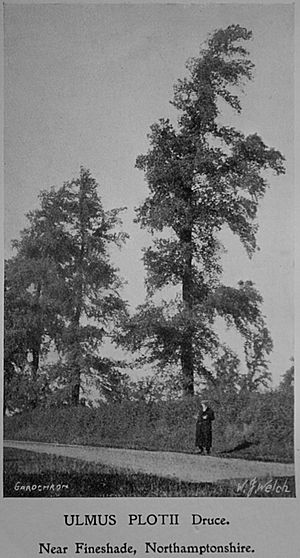George Claridge Druce facts for kids
Quick facts for kids
George Claridge Druce
|
|
|---|---|
| Born | 23 May 1850 Potterspury, Northamptonshire |
| Died | 29 February 1932 (aged 81) Oxford |
| Resting place | Holywell Cemetery |
| Occupation | Botanist, academic, public servant |
| Language | English |
| Notable works | Flora of Oxfordshire (1886), Flora of Berkshire (1887), Flora of Buckinghamshire (1926), Flora of West Ross (1929) |
| Notable awards | Honorary MA, University of Oxford (1889) |
George Claridge Druce (born May 23, 1850 – died February 29, 1932) was an important English botanist. A botanist is a scientist who studies plants. George Druce was also a Mayor of Oxford. He was known for his detailed studies of plants across different parts of England.
Contents
Early Life and Education
George Claridge Druce was born in a village called Potterspury in Northamptonshire. His mother was Jane Druce, who was born in 1815.
He went to school in the nearby village of Yardley Gobion. When he was 16, he started training to become a pharmacist. This training was with a company called P. Jeyes & Co. in Northampton. In 1872, he passed his exams and became a qualified pharmacist.
Later in his life, in 1909, Druce moved to a house in Oxford. He named his new home "Yardley Lodge." This name was a tribute to the village where he grew up. He passed away at his home when he was 81 years old. He was buried in Holywell Cemetery in Oxford.
Career as a Pharmacist
In June 1879, George Druce moved to the city of Oxford. There, he opened his own chemist's shop, called Druce & Co. His shop was located at 118 High Street. He continued to run this shop until he died.
Interestingly, his shop even appeared in a famous Oxford novel. The book was called Zuleika Dobson and was written by Max Beerbohm. In April 2018, a special plaque was placed on his old shop. This plaque honors Druce and his contributions to Oxford.
Amazing Plant Discoveries
George Druce's biggest passion was botany, the study of plants. He loved learning about and identifying different types of plants.
In 1876, he helped start the Northampton Natural History Society. This group was for people who were interested in nature.
In 1880, Druce also helped create the Ashmolean Natural History Society of Oxfordshire. This society was for studying nature in the Oxford area. Druce later combined it with another local nature group in 1901.
Druce wrote several important books about plants. These books are called "floras." A flora is a list or description of all the plants found in a certain area.
- In 1886, he published The Flora of Oxfordshire.
- In 1887, he wrote The Flora of Berkshire.
- In 1926, he published The Flora of Buckinghamshire.
- In 1929, he completed The Flora of West Ross.
It was very rare for someone to write floras for more than one county. This shows how dedicated he was to studying plants across different regions.
One of his special discoveries was a rare type of Field Elm tree. He noticed this unique, narrow-leaved elm in the English Midlands. He named it 'Plot's Elm'. He named it after another Oxford botanist, Robert Plot.
Serving the City of Oxford
George Claridge Druce was also very involved in the local government of Oxford. He served on the Oxford City Council from 1892 until he died. He was in charge of the Public Health Committee, which looked after the health of the city.
He was the Sheriff of Oxford in 1896–97. To celebrate Queen Victoria's Diamond Jubilee in 1897, he gave the City of Oxford a special gold chain and badge for the Sheriff. These items are still kept in the Town Hall.
Druce became the Mayor of Oxford in 1900–01. To mark his time as Mayor, a stone was put up at the city boundary in Headington. This stone has his name carved on it. In 1920, Druce was given the title of Alderman. You can see a portrait of him in his robes in the Council Chamber at the Town Hall.
Honors and Legacy
Because of his important work, the University of Oxford gave him an honorary Master of Arts (MA) degree in 1889. In 1895, he became the Fielding Curator in the Department of Botany at the University. This was a special role helping to manage the university's plant collections.
He was also a Fellow of the Royal Society. This is a very high honor for scientists in the United Kingdom.
George Druce collected many plant samples, which are called a herbarium. His collection was combined with another important collection. Together, they formed the Fielding-Druce Herbarium at the University of Oxford. This collection is still used by scientists today to study plants.
List of Works
- The Flora of Oxfordshire (1886)
- The Flora of Berkshire (1887)
- The Flora of Buckinghamshire (1926)
- The Flora of West Ross (1929)



